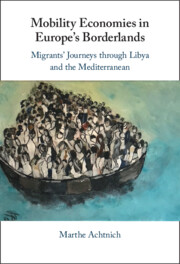120 results
11 - The Chacay Massacre
-
-
- Book:
- Mobility and Coercion in an Age of Wars and Revolutions
- Published online:
- 09 May 2024
- Print publication:
- 16 May 2024, pp 235-257
-
- Chapter
-
- You have access
- Open access
- HTML
- Export citation
12 - Non-EU Nationals
-
- Book:
- European Union Law
- Published online:
- 19 March 2024
- Print publication:
- 28 March 2024, pp 502-547
-
- Chapter
- Export citation
Competing Visions and Constitutional Limits of Schengen Reform: Securitization, Gradual Supranationalization and the Undoing of Schengen as an Identity-Creating Project
-
- Journal:
- German Law Journal ,
- Published online by Cambridge University Press:
- 20 February 2024, pp. 1-20
-
- Article
-
- You have access
- Open access
- HTML
- Export citation
Addressing Algorithmic Errors in Data-Driven Border Control Procedures
-
- Journal:
- German Law Journal ,
- Published online by Cambridge University Press:
- 13 February 2024, pp. 1-11
-
- Article
-
- You have access
- Open access
- HTML
- Export citation
Postsocialism in International Relations: Method and critique
-
- Journal:
- Review of International Studies / Volume 50 / Issue 3 / May 2024
- Published online by Cambridge University Press:
- 01 February 2024, pp. 494-513
- Print publication:
- May 2024
-
- Article
-
- You have access
- Open access
- HTML
- Export citation
Between race and animality: European borders, ‘colonial dogs’, and the policing of humanity
-
- Journal:
- Review of International Studies , First View
- Published online by Cambridge University Press:
- 01 February 2024, pp. 1-18
-
- Article
-
- You have access
- Open access
- HTML
- Export citation
Transatlanticism: A fading paradigm?
-
- Article
-
- You have access
- Open access
- HTML
- Export citation
10 - The “Other” Boundary Problem
- from Part II
-
-
- Book:
- When the People Rule
- Published online:
- 23 November 2023
- Print publication:
- 09 November 2023, pp 189-203
-
- Chapter
-
- You have access
- Open access
- HTML
- Export citation
5 - Stuck
- from Part II - Malta
-
- Book:
- Mobility Economies in Europe's Borderlands
- Published online:
- 12 October 2023
- Print publication:
- 26 October 2023, pp 119-148
-
- Chapter
- Export citation
Conclusion
-
- Book:
- Mobility Economies in Europe's Borderlands
- Published online:
- 12 October 2023
- Print publication:
- 26 October 2023, pp 168-175
-
- Chapter
- Export citation
6 - Moving On
- from Part II - Malta
-
- Book:
- Mobility Economies in Europe's Borderlands
- Published online:
- 12 October 2023
- Print publication:
- 26 October 2023, pp 149-167
-
- Chapter
- Export citation
2 - Staying On
- from Part I - Libya
-
- Book:
- Mobility Economies in Europe's Borderlands
- Published online:
- 12 October 2023
- Print publication:
- 26 October 2023, pp 58-82
-
- Chapter
- Export citation
Introduction
-
- Book:
- Mobility Economies in Europe's Borderlands
- Published online:
- 12 October 2023
- Print publication:
- 26 October 2023, pp 1-26
-
- Chapter
- Export citation

Mobility Economies in Europe's Borderlands
- Migrants' Journeys through Libya and the Mediterranean
-
- Published online:
- 12 October 2023
- Print publication:
- 26 October 2023
4 - Walled World
-
- Book:
- COVID and Climate Emergencies in the Majority World
- Published online:
- 22 June 2023
- Print publication:
- 06 July 2023, pp 26-32
-
- Chapter
- Export citation
1 - Sultans of the Open Lands (1858–1890)
-
- Book:
- Locusts of Power
- Published online:
- 16 June 2023
- Print publication:
- 25 May 2023, pp 24-83
-
- Chapter
- Export citation
3 - “Weren’t We A Lot Like Those Creatures?” (1908–1918)
-
- Book:
- Locusts of Power
- Published online:
- 16 June 2023
- Print publication:
- 25 May 2023, pp 135-190
-
- Chapter
- Export citation
2 - “Savage Swarms” (1890–1908)
-
- Book:
- Locusts of Power
- Published online:
- 16 June 2023
- Print publication:
- 25 May 2023, pp 84-134
-
- Chapter
- Export citation
Cold War Narcotics Trafficking, the Global War on Drugs, and East Germany's Illicit Transnational Entanglements
-
- Journal:
- Central European History / Volume 56 / Issue 2 / June 2023
- Published online by Cambridge University Press:
- 24 April 2023, pp. 214-235
- Print publication:
- June 2023
-
- Article
-
- You have access
- Open access
- HTML
- Export citation
A River Runs through It: The Elbe, Socialist Security, and East Germany's Borders
-
- Journal:
- Central European History / Volume 56 / Issue 2 / June 2023
- Published online by Cambridge University Press:
- 24 April 2023, pp. 196-213
- Print publication:
- June 2023
-
- Article
-
- You have access
- Open access
- HTML
- Export citation



